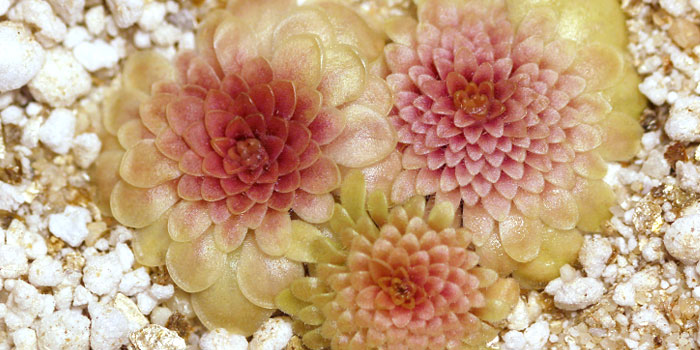Tropical and Mexican butterworts can make a wonderful addition to any carnivorous plant collection. They are great for catching gnats and are a good option for beginners and expert growers alike! Have questions about how to care for your butterwort? Check out our comprehensive care guides below.
Potting
This video will make potting your new butterwort quick and easy! We cover everything you’ll want to know including supplies needed, inspection of the plant, and planting methods.
Acclimation
After potting, your butterwort will go through an important adjustment period over the next few days. Learn how to help it adjust to its new home >>
Water and Humidity
In this video on water and humidity for tropical and Mexican butterworts, we cover a variety of topics including drainage, watering frequency, and watering methods. Proper water and humidity control is important to the long term health of your butterwort.
Feeding
When your butterwort is in its carnivorous phase, it’s important that the plant gets plenty to eat. While butterworts are pros at catching gnats on their own, sometimes there aren’t any to catch. In this case, supplemental feeding can be beneficial. See our guides on feeding carnivorous plants here:
Light

Quantum weighted Relative Action Curve adapted from McCree, 1972.
Proper butterwort care includes adequate lighting. For an in-depth look at lighting for carnivorous plants, including butterworts, check out our three part article series:
- Part 1 – What type of light do carnivorous plants need?
- Part 2 – How much light do carnivorous plants need?
- Part 3 – Which grow lights are best?
Succulent Phase (Dormancy)
Many tropical and Mexican butterworts experience a succulent phase, or what is often referred to as a dormancy period, hibernation, or winter rosette phase. Learn more about succulent phase care >>





To the owner and wife of Curious Plant, thank you very much for the informational videos. A great help! I just got introduced to the carnivorous plant. Really neat. Question/Comment: When purchasing a plant it would be helpful to have an appropriate pot along with it. Is this reasonable considering mailing restraints? Please advise. Thank you again. Looking forward to future business with you all. Monty
Thank you Monty, we’re glad you found the videos helpful!
We have pots available at the link below that work for most of the plants but do not include them automatically as many growers already have other plans for how they would like to arrange or pot them.
https://curiousplant.com/product/pots-and-care-supplies/square-pot/
I was seeing you can plant these on lava rocks.
So I thought a substrate of smaller lava rocks would be good for the plant. But now that I planted them in the rocks the plant kinda is floating on top and isn’t too attached yet, is that fine?
Are they able to grow on lava rocks?
Yes lava rock is ok to grow Pinguicula on. If there are large gaps between the pieces, this can cause the media to dry out really fast so you’ll want to make sure it stays well hydrated. This will help the plants settle in more easily and attach themselves to the substrate. If the plant is loose initially that’s no problem as long as it’s getting enough moisture.
Hi I have a Pinguicula agnata ‘Red Leaf’ x rectifolia and while it showed up with red leaves it hasn’t really produced any over the last 4 months. It gets a lot of indirect light from a south facing window and looks healthy and currently even has two flowers and two buds. I also use blood worm to keep it fed. Wondering what I need to do to get that pretty red back?
Hi Andrew, glad to hear the plant is getting lots of new growth and flowers! In order to maintain the red color on the leaves, the plant will need to receive plenty of direct light. Several hours of direct sun can work or keeping the plant under a strong grow light can help bring out the color as well. Thanks so much!
Do you meed a special grow light for the carnivorous plants or will bright artificial light do.
Hi Terri, a light specifically made for growing plants isn’t necessarily required however if it will be the primary light source, you’d want to make sure the one selected will be adequate for the plant’s needs. The links in the resources above under the lighting section go into detail about what to look for as far as specs and how to get a rough estimate of the strength and quality of the light it produces. There is also a section with some recommended lights that typically work well for growing carnivorous plants.
If my butterwort came with flowers should I trim those to help with acclimatization?
Hi Justin! When it comes to acclimating butterworts, keeping or removing the flower doesn’t typically have a significant effect on the process. It is common for flowers that were already bloomed on arrival to die away sooner though so if you’d prefer to remove them for the sake of appearance, there wouldn’t be any harm until the plant grows new ones. Thank you!
Is there a “preferred” time of season that butterworts would fare better for repotting? Some plants, like succulents, prefer repotting during certain growth periods and I’m wondering if butterworts have the same type of rules.
Hi Maureen, repotting butterworts can be done at anytime but the most optimal would probably be during their succulent phase. The leaves are usually smaller and less dewy during this phase so the plant doesn’t need to work as hard to retain moisture which can be helpful as it settles back in after the repotting.